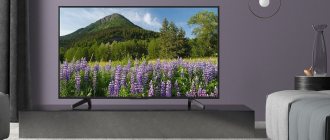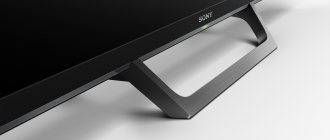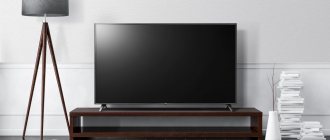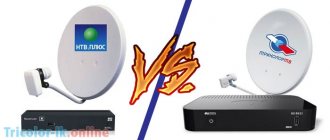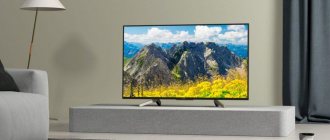Many interesting TV models have already been released in 2021. We have compiled a rating in which we have categorized devices by cost and screen diagonal.
The review did not include TVs with HD-Ready resolution (720p). Now this format can only be used on a small kitchen TV with a diagonal of about 20-32 inches. We also did not consider TVs with 8K: their cost usually exceeds a million rubles, and there is still little content for them. We will focus on the Full HD (1080p) - 4K/Ultra HD (2160p) range.
There will be four groups in total:
- The best TVs with a diagonal of 43-49 inches
- The best TVs with a diagonal of 50-55 inches
- The best TVs with a diagonal of 56-80 inches
- The best TVs in the premium segment
This year, the 4K TV market has grown quite strongly, and almost half was occupied by devices from Samsung (31%) and LG (16.6%), so it should not be surprising that there are more models from these brands in the review than others.
All TVs in our review, even the most budget ones, are equipped with Smart-TV, since in 2020 this is already the required minimum.
What is most important when choosing a TV in 2021
To avoid overpaying for TV, but also to buy the most functional model according to your personal criteria, you will need to take into account a number of parameters. And not in all cases the issue of cost will come first. After all, you need to understand that you need to pay for a high-quality, functional TV. Of course, among less popular brands it is possible to find a model that satisfies you, but this is more difficult to do.
Which TV to choose in 2021? To answer this question, you need to decide for yourself personally on a number of technical parameters. Accordingly, if you can set priorities for yourself, then the search will take a minimum of time.
To choose the right TV in 2021, you need to consider the following technical characteristics:
- Diagonal.
- Type of matrix and backlight.
- Screen resolution.
- Brightness and contrast.
- Sound quality.
- If Smart-TV, what OS is installed.
- Is the model equipped with additional functions?
Manufacturer
The most important thing in the question of which TV to choose in 2021 is which brand to choose. Which company should you prefer?
From the above it is clear that the correct choice of a TV device depends on a number of parameters, but the manufacturer is most often considered one of the key ones. Experts insist that you need to purchase a device based on personal preferences. Since modern TVs are created on an almost identical principle. The brand does not play a special role in this situation.
Many buyers are confident that all companies use personal technology when releasing specific models. To understand which brand of TV is best, you need to familiarize yourself with the company's features.
Each manufacturer has certain features that are unique to it. For some they are superfluous in the device, for others, on the contrary, they are an excellent addition.
The appearance also varies depending on the company. Here everything is purely individual, for each client. This also applies to the available budget for purchase.
Experts recommend comparing all models from different manufacturers at once based on technical characteristics, appearance and additional functions that are important to you in the device. Ultimately, you can choose the most optimal TV that meets your criteria. It's time to open the ranking of the best TVs in 2021.
Screen criteria
One of the main criteria for choosing a TV is the screen. And here we are not talking about picture quality or detail, contrast, but about size. The diagonal plays the main role, and the technical characteristics fade into the background. At the same time, buyers are sure that the larger the diagonal, the better. But this selection principle is suitable for rooms over 25 square meters. meters where the TV will be located. For a small room, a diagonal of 50 inches is not the best solution, as well as for a living room or kitchen-living room of 32 inches.
Experts advise considering the following points:
- where is the TV installation planned?
- what is the distance from the TV to the sofa, chair or bed, table;
- room area.
It is believed that the ideal size is on average a third of the distance to the viewer from the TV. At the moment, each buyer chooses the appropriate option personally according to his taste. The most common models are from 32 to 55 inches. For a kitchen or small bedroom, you should choose something more compact.
Next, we will look at the characteristics that you need to pay attention to after the diagonal is selected.
Matrix type
The main point in the question of how to choose a TV for your home in 2021 is the type of matrix. Because the quality of the picture and even the price of the equipment depend on this.
To see the difference between the types of matrix with your own eyes, visit a shopping center or hardware store, and also watch a video on YouTube. There are many videos where bloggers compare different TVs, describing the advantages and disadvantages of one or another option.
Most often the choice is between LCD and OLED. LCD TVs use an LCD matrix, very familiar to us from monitor screens. If we talk about the principle of operation, it boils down to the following: LEDs and lamps create radiation, LCDs partially or completely block the light source to form a color of a specific contrast. LCD matrices are divided into a couple of subtypes: IPS is better than TN+film, but worse than VA. At the same time, the backlight itself also works on the basis of different principles. There is also CCFL (combustion lamp illumination) and LED technology, which is based on the use of diodes. It was the latest version that improved the quality of color reproduction and significantly influenced the reduction in the thickness of the TV.
LCD and LED backlighting is available in two types:
- Direct – DirectLED. The backlight is located behind the matrix, accordingly, this allows for uniform illumination across the entire plane of the screen. Also, due to this technology, high-quality local dimming is created, used in HDR mode.
- Contour − Edge LED. In this case, the LEDs are located along the contour of the screen itself, and a clever reflection system allows you to distribute the backlight across the entire display. This technology is considered more affordable.
Most manufacturers are confident that LCD and LED technologies are the future, so they are producing more TVs with such a matrix. Among the advantages of the technology are:
- affordable price when compared with OLED;
- acceptable thickness and small dimensions;
- normal screen brightness.
Regarding OLED, these are one of the latest TV models. The image is produced by a matrix with organic light-emitting diodes. These elements are represented by small particles made of light-emitting organic materials. In this case, additional lighting is not needed, due to which manufacturers create the thinnest possible models, but while maintaining the depth of black color.
Permission
We are talking about the size of the picture, which is measured in pixels. And here you need to build on the principle that the higher the numbers, the better and clearer the image will be. There are four types of resolution in modern TVs:
- HD (1280x720/1366x768 pixels) - more often found in inexpensive models or TVs with a small diagonal.
- Full HD (1920x 1080) is the most common device. The price is affordable and the picture quality is average.
- Ultra HD – 4K (4096x 2160/3840x 2160) – this technology is found in models over 32″ diagonally. Here the image is of better quality, but the price is higher.
- Ultra HD – 8K (7680x4320) – a representative of modern technologies. Moreover, the range of models that support this resolution is not diverse, and since the price is high, these TV models are not the most affordable.
When searching for TV, be guided by the purposes for which you are making a purchase. To watch analog TV, it makes no sense to buy a model that supports Ultra HD. You can get by with the simplest TV.
Is LED needed?
It is very difficult to answer this question specifically. Because to some extent it all depends on the personal preferences of each buyer. LED backlighting is used quite often in LCD TVs. With the development of technology, manufacturers of this group of equipment began to pay attention to increasing the contrast ratio. This indicator especially has a strong impact on how the picture looks on the screen.
Then gradually brands started using LED lighting. This technique has proven to be excellent, with low power consumption and excellent capabilities for adjusting the level of glow.
Popular manufacturers prefer LED TVs. There are several varieties of this backlight; it is divided depending on the location of the LEDs themselves. It is important to realize that each type of LED lighting has its own technical characteristics. There is back and side lighting, the latter is used by companies more often because it reduces the thickness of the TV.
Contrast and Brightness
Contrast (written as a ratio, for example, 5000:1) tells how much brighter the white areas on the screen are than the black areas. For example, in LED TVs the contrast is low, while in OLED it is high. Many people recommend choosing a model with a 5000:1 ratio. To achieve the highest quality images, manufacturers use dynamic contrast. Thanks to this technique, the brightness automatically switches depending on what scene is on the screen.
Brightness is an important parameter worthy of attention. This is the luminous intensity per m2, indicated in the technical specifications as cd/m2.
It is important to choose a middle ground here, since very high brightness can be a catalyst for loss of contrast. Companies producing models in the budget segment are presented with a brightness of up to 300 cd/m2, more expensive options are about 400 cd/m2, and the most expensive ones are about 600 cd/m2. It’s difficult to say which is the best TV for this indicator. Here it is also important to take into account the type of matrix, the diagonal of the TV, and, of course, personal preferences.
Frequency and response time
Let's start with frequency - a parameter that is measured in hertz; this is the number of image updates on TV in 1 second. For example, 60 Hz - in 1 second the picture is updated 60 times. It is known that frequencies greater than 60 Hz are not detected by human vision. It is best to choose models with an average refresh rate of 200 Hz.
The next indicator that requires attention is recall time. This parameter characterizes the change in the position of the crystal in each pixel. The response time determines how quickly the picture changes at the moment of movement. When the response is low, there is a chance that loops can be seen on the screen, which significantly reduces the comfort during viewing.
Which TVs support digital television without a set-top box?
Any major network offers various models and brands of digital TVs. The names and new terms simply dazzle your eyes - LCD, Led, HD, FULLHD, plasma. But all these designations do not mean that these television receivers show digital channels without a set-top box; you need to pay attention to a completely different point. Namely, the presence of a tuner (receiver) capable of receiving and decoding a digital terrestrial signal.
You shouldn’t even think about whether all LCD TVs will be suitable for digital reception after the nationwide transition to this broadcast format. A significant part of them will not allow receiving channels available in free multiplexes.
To avoid making a mistake when purchasing and purchasing a TV that cannot help you in any way, first of all pay attention to the type of built-in receiver.
The most common tuner versions are:
- DVBT is an outdated receiver that provides broadcast digital reception in the old format.
- DVBC is a block that provides the ability to connect to digital cable television.
- DVBS and DVBS2 are receivers necessary to gain access to satellite television capabilities.
Design
Regarding the appearance of TVs. It cannot be said that there are any special differences. Of course, each manufacturer has features, and there are thinner models. You can also choose a model in white, gray, or silver, but most often manufacturers prefer black. This option is considered the most versatile and will look great in any interior.
The next point is the legs. Some manufacturers include two sets of legs, one curved, the other straighter. If you intend to hang the TV on the wall using a special mount, then the shape of the legs is not important to you.
In most cases, there are no unnecessary elements or buttons on the TV body; everything is done in minimalism. You should buy a TV based only on its design if you don’t care about the image quality and its functionality.
Does the TV support digital television - how to find out?
Now a few words about how to understand whether a TV purchased 3-4 years ago will show digital channels. The problem is solved using fairly simple methods:
- Carefully study the documentation (passport, instruction manual) available for your TV. All information about the configuration, including the presence of a tuner, methods for connecting the antenna and the tuning algorithm will be indicated in these documents.
- If you are sure that your TV definitely has a built-in receiver, but you don’t know how to check whether it will work with digital terrestrial television, start with an external inspection. To connect the antenna to the built-in DVBT2 tuner, use a standard connector, as well as for receiving an analog signal, that is, a regular antenna plug. In most cases, the connector is labeled "ANTINAIR/CABLE". Tuners that receive signals from a cable or satellite provider are equipped with input connectors of a different type; it is almost impossible to confuse them.
- In the next step, check the ability to configure digital channels. To do this, go to the “Broadcast” menu section, select “Auto Configuration”, click “Start”. In the menu that appears, select the “Antenna” subsection, which refers to the reception of digital terrestrial television, confirm the type of channels required - digital or analog and digital.
This testing method is suitable for almost all TVs produced in 2014–2019; only the setting algorithm itself can be changed. You will find information on this issue in the instruction manual.
Sound
Sound quality plays a big role for fans of films, TV series or music lovers. Since modern TVs are thin, it is logical that it is unrealistic to insert a powerful sound system into it. It is impossible to say that the sound is bad; if you want a deeper and maximum immersion in what is happening, you will have to buy a home theater. At the same time, there is a luxury segment in 2021, where the TV has a very solid sound design. But the price of the models is much higher.
Models with a built-in Dolby Digital decoder and NICAM support are considered to have the best sound performance. There are also models in which the speaker power is at least 20 W. If sound is important to you, but there is no desire to buy an additional home theater or stereo system, then you should choose a TV for your home with a speaker power of 20 W or more.
The best TVs with digital TV support and their prices
QLED Samsung QE49Q70RAU
LG 50UM7300
Sony KD-65XF9005
All of the listed tuner modifications are, of course, necessary, but not for receiving broadcast digital data in a modern format, which will be broadcast throughout Russia. You need a DVBT2 TV with a built-in receiver, or you can purchase a TV receiver with advanced devices that operate in two formats, for example, DVBT2 / DVBC or DVBT2 / DVBS2. But let’s say right away that such models are significantly more expensive.
Therefore, when purchasing, be sure to check with your consultant whether the selected model is equipped with a tuner of this class.
operating system
If you are looking for a TV with a Smart TV option, then you should take into account that the operating system also changes depending on the manufacturer. Each OS has its own characteristics. Therefore, in order to decide which brand of TV is better to choose with Smart TV, you need to consider the characteristic features of each option.
Initially, you need to say that this is a TV that has an OS with already built-in applications, through which you can connect to the Internet. This, in turn, allows you to view a variety of content from the Web. The Internet comes through Wi-Fi or an Internet cable.
Companies use different operating systems during the production process. For example, the Sony and Philips brands have Android TV, LG has WebOS, and Samsung has Tizen. Please note that such TVs are more expensive than without Smart TV.
If the user does not want to overpay for the Smart TV function, you can buy a Smart TV set-top box separately. By connecting the receiver, you can download any applications. The price of the set-top box depends on the manufacturer and parameters.
Most often you can find Tizen OS. The key advantage of the OS is ease of management and flexibility. If you wish, you can change the Smart Hub menu icons on the screen. Also, the system in auto mode divides applications into two columns - frequently used and those that are opened less often.
Features of Tizen OS:
- There is a gyroscope on the remote control.
- Built-in global search.
- Social TV is a feature that allows you to simultaneously communicate on social networks and watch a TV series.
- Webcam face recognition option.
- Smart Interaction Management.
The Android TV operating system is no less common, and this interface is familiar to a considerable number of users. System Features:
- Large list of applications and games for download.
- The remote control can be used as a gamepad.
- There is voice search.
- The interface is intuitive and easy to understand.
The following operating system is WebOS and its features:
- You can work without a browser with YouTube, Picasa and other software.
- There is a convenient Smart Share option for outputting files from an external drive.
- There is a built-in assistant that helps users who have not worked with Smart TV before.
- The Magic Motion remote control can be used as a gaming joystick.
TVs 43 inches 4K UHD
Which is the best TV to buy in 2021? One of the most popular options for small rooms is 42-43 inches. At the same time, it is quite possible to aim for 4K resolution - the corresponding models are not as expensive as before. There is more and more content for 4K, as well as games that support this resolution. What do we pay attention to?
LG 43UM7450 (2019)
- 4K UHD (3840×2160), HDR
- screen diagonal 43 inches, IPS
- screen refresh rate 50 Hz
- Smart TV (webOS)
- sound power 20 W (2x10 W)
- backlight type: Direct LED
- DVB-T2 support
- HDMI x3, USB x2, Bluetooth, Wi-Fi 802.11ac, Ethernet, Miracast
You can blame us for being too fond of the “Koreans,” but LG and Samsung really have an excellent combination of price and quality. For example, the LG 43UM7450 costs about 25,000 rubles, but offers a screen with an excellent IPS matrix and a very advanced audio system for a TV. Users also note the fast Smart TV. Voice search makes it much easier to find the content you need on the Internet. All you have to do is press the remote control button and say what you want to find.
The screen has wide viewing angles: even when viewed at an angle of 60°, the picture is reflected with the same richness of colors that a person sitting directly in front of the TV sees. There is 4K Active HDR optimization, the ability to create DTS Virtual:X virtual sound, simulating a 5:1 format. So we also recommend this model with a clear conscience.
Xiaomi Mi TV 4S 43 T2
- 4K UHD (3840×2160), HDR
- screen diagonal 42.5 inches, IPS
- Screen refresh rate 60 Hz
- Smart TV (Android)
- sound power 16 W (2x8 W)
- DVB-T2 support
- HDMI x3, USB, Bluetooth, Wi-Fi 802.11ac, Ethernet
Xiaomi is another manufacturer that offers 4K TVs with a screen size of 43 inches for a little more than 20,000 rubles. Immediately after its appearance on the market, this model received not the most flattering reviews, primarily due to its buggy software. But over time, several updates came to the devices and now everything is in order with stability. Of the remaining complaints, perhaps the remote control is not the most functional.
The rest is a classic of the genre. Metal case, fairly powerful 64-bit processor, a large number of different interfaces for connection. And, of course, a good matrix with wide viewing angles. Separately, it is worth mentioning the proprietary Patchwall launcher, which gives access to a huge amount of content, with the ability to select it according to your interests. The more you use your TV, the more accurate your recommendations will be.
Samsung UE43RU7410U (2019)
- 4K UHD (3840×2160), HDR
- screen diagonal 42.5 inches, TFT IPS
- Screen refresh rate 100 Hz
- Smart TV
- sound power 20 W (2x10 W)
- DVB-T2 support
- HDMI x3, USB x2, Bluetooth, Wi-Fi 802.11ac, Ethernet, Miracast
Samsung's 7th series has always had a good range of features and above-average performance. This model is no exception. An excellent IPS matrix is used here, the screen refresh rate is 100 Hz. The arsenal also includes a powerful processor, HDR support, and UHD Dimming technology for more accurate rendering of details. The case has a special channel in order to hide the wires in it - nothing will hang and spoil the appearance.
AirPlay 2 support will be very useful for owners of Apple equipment. Using the SmartThings system, you can control smart home appliances, including lighting, from your TV. True, they must also support SmartThings.
The model was updated in 2021 - in particular, it became possible to duplicate the PC screen wirelessly. TV is no longer budget-friendly, but not everyone is interested in saving money.
Interfaces and other functions
Remember that the interface depends on which model and manufacturer you choose. Most often, companies make equipment that is easy to operate and will not be difficult to understand. Moreover, the instructions for modern devices describe in detail all the stages of what needs to be connected and in what sequence.
Moreover, if you have chosen a Smart TV, its contents will differ depending on the operating system. Experts have different opinions regarding the simplest OS interface. Here everything depends on the personal preferences of the user and the tasks assigned to the device.
Regarding additional options. Here, a special place is occupied by the question of connectors, their types and quantities. You can connect a different number of additional equipment to the TV - from players to speakers, but it is important that the manufacturer provides for the presence of such connectors.
The model you choose must have the following ports:
- HDMI;
- DVI;
- USB port;
- component and composite input;
- analog output for stereo sound;
- antenna input for receiving analog TV.
When you have all the most popular connectors, you can easily connect various kinds of gadgets to your TV.
Additional options also include 3D format. There is debate regarding this function, and not all experts believe that in an apartment, even with a TV of the largest diagonal, it will not be difficult to immerse yourself in 3D, which is presented in a cinema. Therefore, you probably shouldn’t overpay for this option.
Further, the anti-glare screen allows you to enjoy viewing even in very intense lighting. Watching TV series, movies or playing games is more comfortable, especially if the bright sun is shining into the room or intense sources of artificial lighting are turned on.
The picture-in-picture feature is considered a good addition. This technology allows you to watch several TV channels at once. An equally useful option is maintaining a memory card. In this case, the TV has a special connector that allows you to directly connect memory from a mobile phone, camera or tablet.
The next additional feature is 24p True Cinema, which allows you to present content at the same rate as it was filmed - 24 frames per second. Thanks to this option and speed, eye strain is reduced.
Voice and gesture control – the operation process is greatly simplified, since now you no longer need to constantly monitor where the remote control is located. The technology is not easy, but you can get used to it.
The “progressive scan” option guarantees a clear and high-quality picture due to sequential frame transmission.
Which TVs do not support digital television?
Let us immediately note that broadcasting of a digital terrestrial signal will not be able to be received by old analog televisions with picture tubes. Finding such a device with a built-in DVBT2 receiver is almost impossible. Even if the equipment has a tuner installed, it will most likely only support the DVBT format, which is already outdated and is not used when broadcasting TV channels. Therefore, it is not worth even considering the possibility of using such devices for working with digital broadcasting without additional devices.
Among plasma and LCD TVs of various types, you will not find devices with T2 tuners if they were released before 2012. And in 2013-2014, the share of models with such equipment was insignificant.
Image Contrast
Here we can distinguish between static and dynamic contrast, and this is the only way to compare this parameter in individual models. Contrast usually means how many times the brightest point on the screen is brighter than the darkest point. Such measurements are carried out in the laboratory, but this does not change the fact that it affects the quality of image reception.
Static contrast is calculated by simultaneously displaying the maximum white and maximum black image (for example, a chessboard) on the screen and then calculating the static contrast. Dynamic contrast is measured by displaying the brightest image, then the darkest, and the value is recalculated
Update frequency
This is a setting that determines how often the image is updated on the screen. This is extremely important when watching fast-paced scenes or for people using the TV as a gaming monitor. When the frequency is low, it makes dynamically changing images blurry. By default, LED TVs have a refresh rate of 100 Hz. This DVD quality is sufficient at a resolution of 720 x 576. At a resolution of 1920 x 1080, a suitable refresh rate would be 120 Hz or higher. And for 4K and 3D images, a refresh rate of 240 Hz or more is recommended.



